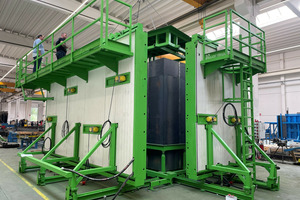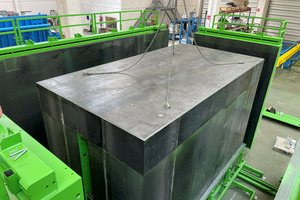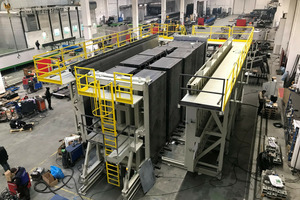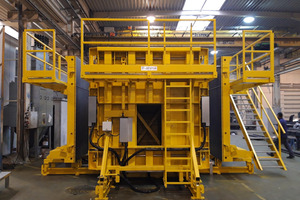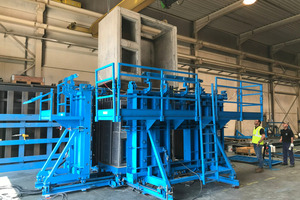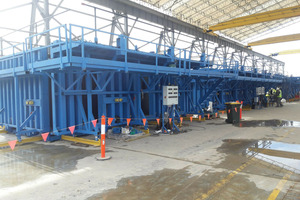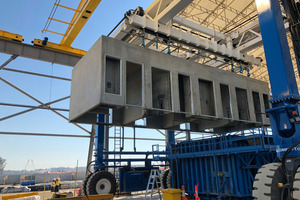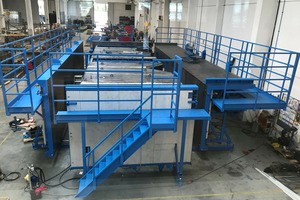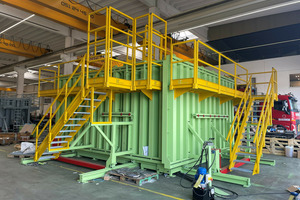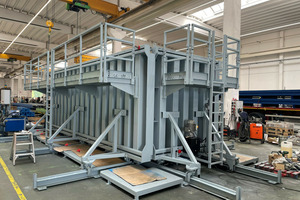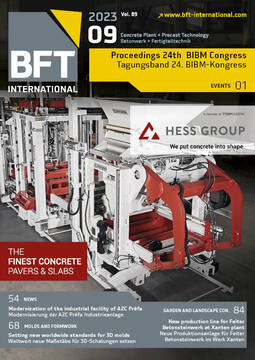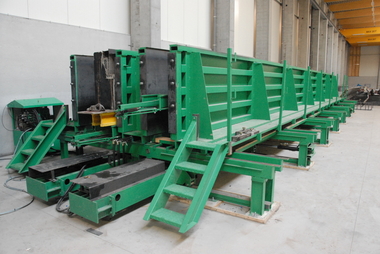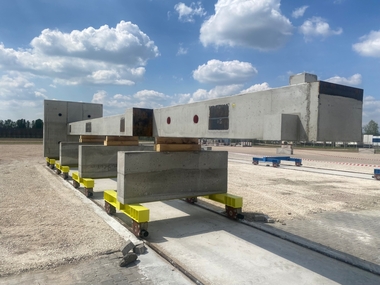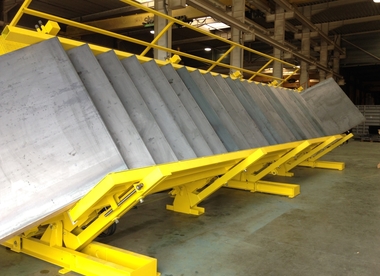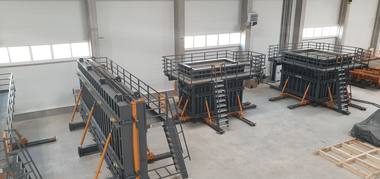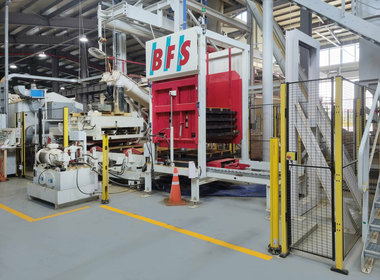Setting new worldwide standards for 3D molds
As one of Europe’s leading mold manufacturers, Construx conceived over the years a full range of state-of-the-art 3D molds and continues to set new worldwide standards for 3D molds. Recently, Construx supplied several different types of 3D molds to a number of precast manufacturers all over the world.
As one of Europe’s leading mold manufacturers, Construx conceived over the years a full range of state-of-the-art 3D molds. Either with a fixed geometry, adjustable or even fully automated, 3D molds are amongst the most complex molds due to their particular design, special features and technical specifications. Whilst being ‘Top of Mind’ when it comes to supplying molds for electrical substations, prison cells and other types of pods, Construx continues to set new worldwide standards for 3D molds, according to the supplier. Recently, Construx supplied several different types of 3D molds to a number of precast manufacturers all over the world.
Poland: Fully adjustable substation mold
These substations are poured upside-down and turned 180° after demolding. This fully hydraulically and electrically controlled substation mold is conceived to manufacture 4 different lengths and 2 different widths with following possible dimensions: - Inside length adjustable: 3150mm, 3800mm, 4200mm and 4700mm; - Inside width adjustable: 2600mm and 3000mm; - Inside height steplessly adjustable from 2400mm to 3000mm; - Wall thickness adjustable: 90mm and 120mm.
Construx also provided 2 different top parts for the inside mold, to be able to make elements with sharp edges between floor and walls or with large chamfers at both ends, a typical feature to accommodate underground duct connections?
The outside mold has hydraulically movable panels. Vibrating the elements is done with high frequency vibrators. The inside mold has a fixed part and several movable parts, according to the above modularity. The intermediate parts can be fit in individually or together. When demolding, first the inside corners are pulled down hydraulically after which the wall panels are also pulled down in the same way, this leaves an 8mm opening on all sides.
Germany: PLC controlled fully hydraulically and electrically adjustable mold
As for the mold above, these substations are also poured upside-down. After demolding they are turned 180° on a 65T capacity double tilting station before they are transported by an overhead crane to the finishing bay. This fully hydraulically and electrically controlled substation mold is conceived to manufacture 8 different lengths and 3 different widths with following possible dimensions: - Inside length adjustable from 2180mm to 6380mm, with 600mm increments; - Inside width 2300mm, 2500mm and 3780mm; - Inside height from 2500mm to 3600mm, steplessly adjustable; - Wall thickness adjustable from 100mm to 200mm, with 20mm increments; - Floor thickness from 120mm to 300mm, steplessly adjustable.
The outside mold has 3 hydraulically movable panels, the fourth panel can be opened electrically over a distance of 3000mm. Vibrating the elements is done with 30 high frequency vibrators. The inside mold has a fixed part and a movable part with modular intermediate parts of 600mm, 1200mm and 2400mm, which can be fit in individually or together. The width of each module and of the complete inside mold can be adjusted with one single movement by means of electric spindles. The intermediate parts can be prepared on beforehand in order to speed up the adjustment of the mold. When demolding, first the inside corners are pulled down hydraulically after which the wall panels are pulled down in the same way. All hydraulic rams and electric spindles are controlled by means of a PLC with touchpad which also shows the workflow graphics.
For manipulating the substations, Construx conceived a 180° turning station with a 65T capacity. This device consists of a set of 2 combined 90° tilting stations with a 6m transport system in between, so the customer can either tilt the elements 90° or turn them 180°. It also has a 14m long transverse movement for transporting the substations to the finishing bay.
Belgium: Fully automated and hydraulically operated substation mold
Because the main walls of the substations are straight and only the basement walls, both inside and outside, are tapered, the demolding needs to be done hydraulically. The mold has 2 hydraulically shrinkable inner cores and 4 hydraulically movable outside panels. Not only shrinking and moving are hydraulic, but also securing the outside panels is done with a hydraulic wedge system. Before the outside panels can be opened completely, they are slightly pushed backwards by means of a hydraulically operated eccentric device. The actual demolding of the element is initiated by pushing the bases up and consequently lifting the element out of the mold by means of 6 perfectly synchronized hydraulic rams and 6 air vents.
Construx provided the complete mold with electronic valves, sensors and a control panel, thus controlling all movements and securing the right sequence of movements, which resulted in a “fool-proof” system.
List of sensors:
On every corner joint: check wedge open or wedge closed
On every wall: check wall open or not
On every corner of the shrinking core: check core completely out or core completely in
On the push-up system: check system out or system in / bottom in or bottom out
Sequence of demolding operations:
Pulling wedges on the outside corners
Pushing walls slightly open
Opening walls completely
Shrinking of inner core
Pushing up the concrete element.
Sequence of closing operations:
Expansion of inner core
Closing outside panels (pushers retracted)
Securing the outside panels by closing the wedge connections.
An audio signal and a flashing light indicate when the mold is in operation. The elements are poured upside-down with self-compacting concrete. To facilitate the turning of the element, Construx supplied a special frame connecting the mold onto the customers’ turning device. All the outside panels have working platforms, one of which is equipped with a stair and the 3 others have access ladders. Construx also supplied a roof mold.
Dimensions of the substation:
Length 3525mm x Width 2380mm x Height 2780mm;
Upper part wall thickness: 80mm;
Inside and outside basement walls with various tapers.
The Netherlands: Hydraulically operated adjustable substation mold with complex geometry and architectural outside pattern
This mold stands out by the special feature on the outside panels. The continuous recesses with a wavy pattern and the large bottom rebate, surrounding the top of the mold, create an extra difficulty for demolding the elements. Construx designed the mold suitable for 2 different element lengths, to allow for this adjustability, one of the outside panels can be set at 2 different locations and one of the inside cores can be larger or smaller by adding or removing a large insert.
The mold has 1 inner core that is pulled down hydraulically, 2 hydraulically shrinkable inner cores and 4 hydraulically movable outside panels. Before the outside panels can be opened completely, they are slightly pushed backwards by means of a hydraulically operated eccentric device. The actual demolding of the element is initiated by pushing the bases up and consequently lifting the element out of the mold by means of several perfectly synchronized hydraulic rams and air vents. All the outside panels have working platforms, 2 of which are equipped with an access ladder. The elements are poured upside-down with self-compacting concrete. To facilitate the turning of the element, Construx supplied a hydraulic turning device which is adjustable, not only for the 2 actual substation types, but also for future elements with other dimensions. Construx also supplied adjustable basement and roof molds.
Dimensions of the substations:
Length 2449mm and 3449mm x Width 1324mm x Height 2190mm;
Inside and outside walls with various tapers.
Australia (1): Large series of quadruple and double prison cell molds going to Grafton
Construx supplied a series of molds for the largest prison in Australia, the Clarence Correctional Centre which accommodates 1,700 beds. This new correctional facility is located near Grafton, New South Wales, Australia. The Northern Pathways consortium, comprising of Serco, John Laing, John Holland and Macquarie Capital completed the construction by the end of 2020. As the civil works subcontractor for John Holland, Civmec Construction & Engineering was responsible for manufacturing the prison cells. Seen there was no precast company in the area which was capable to supply such a large number of complex cells, Civmec installed a complete precast yard on the building site and ordered the cell molds from Construx. Construx was appointed, not only to design and manufacture but also to ship, install and commission the molds. Before shipment, the molds were set up, tested and pre-commissioned in house. The scope of works included: 1n° Quad-Single Ensuite mold (QSE) and 2n° Double-Double Ensuite molds (DDE). The QSE mold was not only used to pour 4 interconnected cells but also to pour single, double and triple units, with the possibility of pouring insulated or non-insulated outside walls. The same idea applied to the DDE molds, making these molds extremely flexible and multi-functional. The molds allowed to pour outside walls, inside walls, roof and balcony at the same time. A considerable part of the order was to design and supply all forms for window and door openings, box-outs for the smaller cavities, bases with rubber sealants on both sides, adjustable stop-ends and even the toilet-base recess formers.
All three molds were designed and manufactured according to current standards, and they included hydraulically shrinkable and retractable inner cores and hydraulically moveable outside panels. To comply with local safety standards, the molds had full steel working platforms with access stairs on the outside forms. Although the use of self-compacting concrete was assured from the start, Civmec insisted on having a limited number of electrical vibrators to be able to instigate the pouring process at all times. To guarantee a next day easy demolding Construx provided accelerated curing by means of fans.
Australia (2): Quadruple cell mold going to Melbourne
Another Australian prison of which the cells were prefabricated with a Construx mold was the Chisholm Road Prison in Lara, Victoria. This maximum-security prison which was commissioned late 2022, accommodates 1,248 prisoners, and provides capacity for Victoria’s future growing prison population. John Holland, as Managing Contractor, subcontracted the production of the precast cells to Westkon, one of Australia’s major precast manufacturers. Construx supplied a ‘full option’ quadruple prison cell mold to their Melton yard in Cobblebank, Victoria. The Construx scope of works included design, manufacturing, pre-commissioning, supply, and commissioning of one quadruple cell mold in which the customer could cast a 4-room cell or a 2-room cell, complete with balcony.
The assembly and installation of the mold was carried out by Westkon because no Construx technicians were allowed to enter the country due to the Covid-19 restrictions. To facilitate the installation, Construx provided detailed assembly and operation instructions as well as several series of photographs and videos of the assembly and pre-commissioning in the Construx facilities prior to the shipping. The multifunctional mold was made adjustable, to be able to cast any different wall thicknesses. The cell mold included following items: base frame, hydraulically shrinkable inner cores, hydraulically moveable outside panels, bases with rubber sealants on both sides and full steel working platforms with access ladders. Construx also provided supports and fixation systems for door and window frames, power points boxes, light switch boxes and light fittings, as well as adjustable box-outs with magnets for all other required cavities. Seen the mold was going to be used outside, Construx included steel pipes with outlets on the outside and the inside of the mold for heating and insulation on the outside mold. All hydraulic rams, electrical vibrators and electrical cabinets were fully connected and pre-installed, to reduce the installation time as much as possible.
Australia (3): Fully adjustable box mold going to Adelaide
This fully adjustable mold is conceived to manufacture elements with 6 different lengths and 3 different widths with following possible dimensions:
Inside length adjustable: from 2500mm up to 5000mm, with 500mm increments;
Inside width adjustable: 2200mm, 2500mm and 3800mm;
Height: steplessly adjustable from 1350mm to 2600mm;
Wall thickness adjustable: 150mm, 175mm, 200mm and 250mm.
The outside panels have wheels and sit on rails, as they can be opened and closed by hand using a gear drive. The long outside panels have a 1500mm stroke: 700mm demolding + 800mm adjustability. The short outside panels have a 1750mm stroke: 700mm demolding + 1250mm adjustability. The two long lateral outside panels are 6000mm wide and the two short transverse outside panels are made of a main 2200mm wide panel plus two add-on parts, one of 300mm and another of 1600mm. The inside mold has shrinkable corner panels with interchangeable intermediate panels. Steel bases of 4 different widths sit on height adjusters. Obviously, there are no tie-bars through the concrete elements, only over the top and underneath.
USA: Fully automated mono-box mold going to Hawaii
The system is suitable to make mono-boxes. These elements come with a fixed width and different lengths, forming a minimum size box of 6’ x 6’ and a maximum size of 6’ x 20’:
Inside width: 6’;
Inside length: 6’ to 20’ in steps 1’;
Wall thickness: 8”, 10” and 12”.
The idea of the mold is to start with a stable chassis with integrated rails on which all components can roll into position. Outside panels are also rolling on this frame and height adjusters fit on the chassis. The fixed part of the core consists of a fixed end segment made up of two hydraulic shrinkable corners and a fixed roof plate. A second end segment sits on wheels and is longitudinally movable on the frame. In this way the core can be extended with intermediate segments. Both connected end segments form the minimum box size: 6’ x 6’. When adding infill segments in between the end segments, any other internal length can be achieved. The 2 transverse outside panels of 6’ long have 4 extra extensions of 2” and 4 extra extensions of 4” on both sides, to make the 3 different thicknesses. These 2 transverse panels roll between the 2 longitudinal panels of 22’.
The panels can be connected to make all combinations of wall thicknesses and core dimensions. All panels can open 800mm for demolding and easy access to put rebar and box-outs. Opening and closing the outside panels is done hydraulically.All infill segments and the movable end segments are equipped with a hydraulic lock. This hydraulic locking device consists of 3 individual pins which each have a hydraulic cylinder to activate them. The hydraulic lock avoids workers having to go inside the core when assembling it. All outside panels are equipped with safety floors and access ladders, and Construx also supplied an extra working platform between outside panels and inside core.
Shaping the future of concrete
Construx meets the requirements of every customer, in order to obtain the most appropriate solution to manufacture their precast electrical substations. The outcome of achieving such an objective is always a very satisfied customer. Construx is an engineering-driven manufacturing company relying on the commitment, creativity and experience of its employees. Their aim is to establish a partnership, rather than to be a supplier, in providing turnkey solutions for precast and on-site formwork issues.

